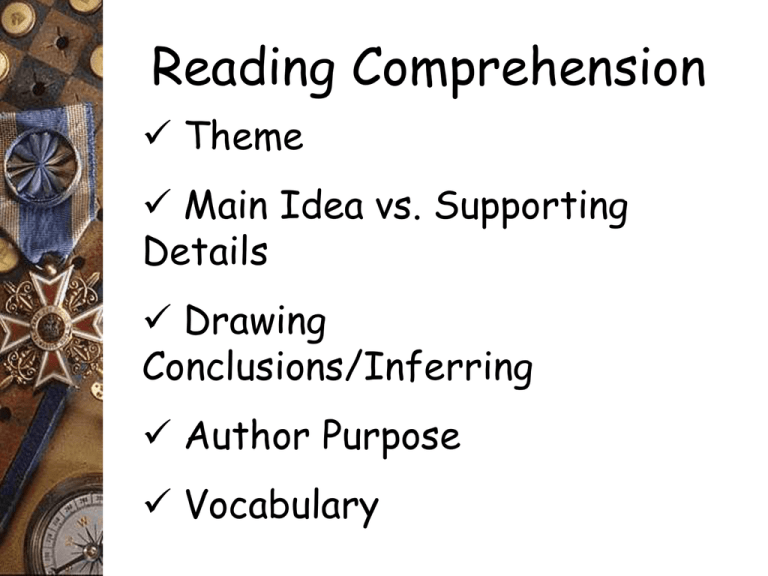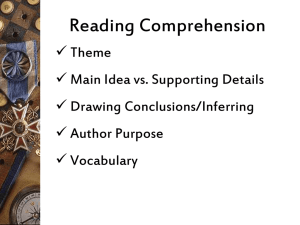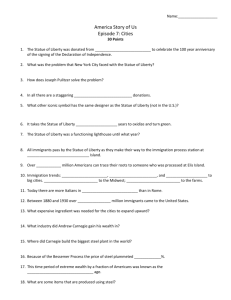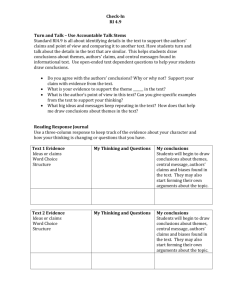Document
advertisement

Reading Comprehension Theme Main Idea vs. Supporting Details Drawing Conclusions/Inferring Author Purpose Vocabulary Theme o Theme is the central or main idea of a literary work. o Themes exist in fictional stories. o A theme is the message or lesson that an author is conveying through the story. What am I trying to teach you? Themes are often what make a story memorable. Long after reading a story, we may forget the characters’ names or the plot, but we will always remember what we learned from reading the story. That lesson is what we call the theme in literature. Living a simple life leads to greater personal freedom. Appearances can be deceiving. True friends are hard to find. Themes are built on the understanding that life experiences are common to all of us. Readers build connections to stories through universal themes. Theme vs. Topic Be careful that you do not confuse the theme with the general topic of a passage. The topic can usually be identified with one or two words. Eastern Europe, pretzels, bike riding, Abraham Lincoln The theme is usually expressed in a sentence that reveals the story’s message. Always be satisfied with what you have. There is no substitute for hard work. Revealing Theme Themes can be revealed through a character’s actions. Do not disturb what is meant to be peaceful. Themes can be revealed through conflict in the story. Problem: Solution: Theme: Two friends find a wallet. One friend wants to return it while the other wants They return the wallet and share a small reward. Making the right decisions can lead to rewards. Read the following passage: In a field one summer's day a Grasshopper was hopping about, chirping and singing to its heart's content. An Ant passed by bearing along with great toil an ear of corn he was taking to the nest. "Why not come and chat with me," said the Grasshopper, "instead of toiling and moiling in that way?" "I am helping to lay up food for the winter," said the Ant, “and recommend you to do the same." "Why bother about winter?" said the Grasshopper. “We have got plenty of food at present." But the Ant went on its way and continued its toil. When the winter came the Grasshopper had no food and found itself dying of hunger, while it saw the ants distributing every day corn and grain from the stores they had collected in the summer. Then the Grasshopper knew: It is best to prepare for the days of necessity. What is the theme of “The Ant and the Grasshopper”? It is best to prepare for the days of necessity. Sometimes, the theme of a story is stated directly. Many of Aesop’s fables, including this one, state the theme as part of the story. Many times, however, the theme is implied. As a reader, you must summarize the author’s ideas into one central idea. Read the following passage: Because of a feud over a piece of land, Ulrich and Georg are bitter enemies. One night they encounter each other on the disputed land. Each thinks of killing the other. Suddenly a huge tree falls and pins them both under its weight. At first the men threaten each other. After a while, however, they notice each other’s suffering, make a pact of friendship, and look forward to being rescued and living in peace. Then they are attacked by wolves. What is the theme of this passage? If you are having trouble finding a sentence within the passage that identifies the theme, that is because the theme is IMPLIED. You need to figure it out for yourself based on the events of the story. What was the conflict in this story? Ulrich and Georg were fighting over land and were even thinking about killing one another. Then a tree fell on them both, Howtrapping was thethem. conflict solved? Ulrich and Georg put their feud behind them and vowed that they would become friends if they were rescued. So now, can you figure out the theme for yourself? Friendship is more valuable than material items. Money is not worth fighting over. Do not let possessions come between friendships. Any one of One story may these themes can apply to this story, and you may be able to think of even more themes that could fit this story. have several themes and not everyone will always agree on a theme. Each story is interpreted differently, so the lessons that Main Idea vs. Supporting o A main idea is the central topic of a text. Detail o Main ideas exist in nonfiction texts. o To find the main idea, think about how you would summarize the entire text into one sentence. Supporting details are the sentences, facts, and examples that explain the main idea. Details are only pieces of the entire puzzle. Read the following passage: Ugh! My camera is all slimy. I was trying to photograph a humpback whale as he blew from his blow hole. It was too close! When a humpback whale breathes, it blows air and water vapor out of its blow hole on the top of its head. The whale's breath, forced out of the hole at 450 kph, is composed of air and water vapor; it can reach 5 meters high and can be seen from 2 kilometers away on a clear day. It contains a fishy smell and oily substance, which can leave a residue on a camera lens, if too close. Whale's breathing or 'the blow' is usually the first sign that This sure was a whale is present. a whale of a tale! What is the main idea of this passage? A) Whale breath can leave a residue on camera lenses B) Whale breath is composed of air and water vapor C) Whales breathe through blow holes on the tops of their heads D) Whale's breathing or 'the blow' is usually the first sign following that a whale Which of the is isa present supporting detail? A) The whale's breath is forced out of the hole at 450 kph B) A whale’s blow can reach 5 meters high C) A whale’s blow can be seen from 2 kilometers away on a clear day D) The whale’s breath contains a fishy smell and What is the main idea of this passage? A) Whale breath can leave a residue on camera lenses B) Whale breath is composed of air and water vapor C) Whales breathe through blow holes on the tops of their heads D) Whale's breathing or 'the blow' is usually Which of the is isa present supporting the first sign following that a whale detail? A) The whale's breath is forced out of the hole at 450 kph B) A whale’s blow can reach 5 meters high C) A whale’s blow can be seen from 2 kilometers away on a clear day D) The whale’s breath contains a fishy smell and Read the following passage: Niagara Falls is one of the most beautiful sights in North America. It is on the Niagara River halfway between Lake Ontario and Lake Erie. Niagara Falls is located on the American and Canadian border. The American Falls is 167 feet high. On the Canadian side, the Horseshoe Falls is 161 feet high. What is the main idea of this passage? A) Niagara Falls is located on the American and Canadian border B) Niagara Falls is one of the most beautiful sights in North America C) Niagara Falls has both the American and Horseshoe Falls D) Niagara Falls is extremely high Which of the following is a supporting detail? A) Niagara Falls is located on the American / Canadian border B) Niagara Falls is on the Niagara River halfway between Lake Ontario and Lake Erie C) The Horseshoe Falls is 161 feet high D) The American Falls is 167 feet high What is the main idea of this passage? A) Niagara Falls is located on the American and Canadian border B) Niagara Falls is one of the most beautiful sights in North America C) Niagara Falls has both the American and Horseshoe Falls D) Niagara Falls is extremely high Which of the following is a supporting detail? A) Niagara Falls is located on the American / Canadian border B) Niagara Falls is on the Niagara River halfway between Lake Ontario and Lake Erie C) The Horseshoe Falls is 161 feet high D) The American Falls is 167 feet high Read the following passage: The Statue of Liberty is visited by thousands of people every year. The Statue of Liberty is a 151 foot statue of a woman holding a book and a torch. It was a gift of friendship from the people of France. It has become the universal symbol for freedom. What is the main idea of this passage? A) The Statue of Liberty is an important symbol for Americans B) The Statue of Liberty is visited by thousands of people C) The Statue of Liberty is a 151 foot statue D) The Statue of Liberty has become the universal symbol freedom Which offor the following is a supporting detail? A) The Statue of Liberty is a 151 foot statue B) The Statue of Liberty has become the universal symbol for freedom C) The Statue of Liberty is visited by thousands of people D) The Statue of Liberty was a gift of What is the main idea of this passage? A) The Statue of Liberty is an important symbol for Americans B) The Statue of Liberty is visited by thousands of people C) The Statue of Liberty is a 151 foot statue D) The Statue of Liberty has become the universal Which the following is a supporting symboloffor freedom detail? A) The Statue of Liberty is a 151 foot statue B) The Statue of Liberty has become the universal symbol for freedom C) The Statue of Liberty is visited by thousands of people D) The Statue of Liberty was a gift of Read the following passage: The Erie Canal changed the way people moved goods in the 1800’s. The 363 mile canal connected Albany, New York to Lake Erie in Buffalo for the first time. When the Canal opened in 1825, building supplies and goods could be transported quickly and cheaply across New York State. Canal boats pulled by mules carried people and supplies across New York. What is the main idea of this passage? A) Canal boats pulled by mules carried people and supplies B) The Erie Canal opened in 1825 C) Building supplies and goods could be transported quickly and cheaply across New York State D) The Erie Canal changed the way people moved goods Which of the following is a supporting detail? A) Building supplies and goods could be transported quickly and cheaply across New York State B) Canal boats pulled by mules carried people and supplies C) The Erie Canal opened in 1825 What is the main idea of this passage? A) Canal boats pulled by mules carried people and supplies B) The Erie Canal opened in 1825 C) Building supplies and goods could be transported quickly and cheaply across New York State D) The Erie Canal changed the way people moved goods Which of the following is a supporting detail? A) Building supplies and goods could be transported quickly and cheaply across New York State B) Canal boats pulled by mules carried people and supplies C) The Erie Canal opened in 1825 Drawing Conclusions / Inferring o Drawing conclusions or Inferring is your ability to figure out what an author means even when he/she does not actually say it. o When you make an inference, you are combining information from the text with your own knowledge to draw a conclusion. INFEREN CE Micah frowned as he stared out the window at the cars all headed in the same direction. “What’s wrong?” I asked him. “Nothing,” he said, but he kept watching the cars and did not change his expression. I watched the cars, too. Every year, hundreds of vehicles drove through our small town on their way to the best circus on the east coast. This year was no different, except that when Micah and I went with our parents to buy tickets, the circus was sold out. For the first “We can go next year,” I told Micah. “Yeah,” he said. “I don’t really care all that much.” He sighed and looked up at me. Though he said he didn’t care, his eyes told a different story. They were puffy as if he was about to cry. He tried to smile, but he could not fool me. I leaned down and Making Inferences Was something bothering Micah? Did you get the feeling that Micah was upset? Do you think you know what upset Micah? If you were able to figure out the answers to these questions, then you made an inference. When you are able to “read between the lines”, you can draw conclusions about the text even when the author does not come right out and tell you exactly what is happening. Making an inference means figuring out what’s going on in a story even when the author does not come right out and actually tell you. Mr. Carleton, your usually cheerful teacher, stands stiffly in front of his desk. He’s holding his arm outstretched; a crumpled piece of paper is pinched between his fingers like the tail of a dead rat. He glares at each student in turn. Nobody dares to move. It’s so quiet you can almost hear the guppies swim in the fishtank. You glance at Jasmine. The confused look on your face asks, “What’s going on?” Jasmine shrugs as if to say, “I don’t know.” Then she starts to whisper, “Mr. Carleton is…” But one look from the teacher stops her in mid-sentence. You didn’t quite catch Jasmine’s last word, but there’s no mistaking her message. What is Jasmine trying to tell you? A) Jasmine thinks Mr. Carleton is happy. B) Jasmine thinks Mr. Carleton is bored. C) Jasmine thinks Mr. Carleton is terrified. D) Jasmine thinks Mr. Carleton is furious. I’ll be marching into Mrs. Lagunovich’s office with this note next! Hopefully you realized that Mr. Carleton is furious, answer D. How were you able to figure that out? Mr. Carleton, your usually cheerful teacher, stands stiffly in front of his desk. He’s holding his arm outstretched; a crumpled piece of paper is pinched between his fingers like the tail of a dead rat. He glares at each student in turn. Nobody dares to move. It’s so quiet you can almost hear the guppies swim in the fishtank. You glance at Jasmine. The confused look on your face asks, “What’s going on?” Jasmine shrugs as if to say, “I don’t know.” Then she starts to whisper, “Mr. Carleton is…” But one look from the teacher stops her in mid-sentence. You didn’t quite catch Jasmine’s last word, but helps Steve there’s no mistaking her message. ME draw! Clues from the author will help you make your inference, but you are also relying on your own experience to help you draw conclusions. Justin grabbed the leash and quickly put it around Tooli's neck. He stormed out the door with Tooli coming right behind. He said, "Hurry up, Tooli. You're always so slow." Justin kept his head down and walked quickly down the road, not speaking to anyone that he saw. If you don’t let go of this leash soon, I’ll be taking YOU for a walk! What was true about Justin? A) He was very worried that someone might see him. B) He was angry that he had to walk the dog. C) He was feeling sick and wanted to lie down. D) He was very excited and wanted to hurry. Jeff filled up a big bowl with fresh, cold water and set it on the floor. He brought out a big comforter and put it on the floor next to the low window. He opened a package, took out a big bone and placed it on the floor next to the comforter. Then he This home is gentle breeze opened the window so that the much better could blow into the room. than my old dumpster! What was Jeff doing? A) He was getting ready for a camping trip. B) He was cleaning out the closet. C) He was getting things ready for his dog. The shelves were piled high with boxes of every size and shape. Each group had a different picture and different bright colors. There were so many people - men and women, mothers with little children, teenagers putting more boxes on the shelves. Some of the people were talking together as they chose the boxes and cans that they wanted. Jeff was having a hard time remembering which one to buy. He knew that Tooli wouldn't be happy if he brought home the wrong brand! He also knew that Tooli was probably getting very hungry! Where is Jeff? A) Jeff was at school in his son's classroom. B) Jeff was at the zoo watching the animals eat lunch. C) Jeff was buying a pet. Due to their incredible force and unpredictability, floods can cause tremendous damage. They can ruin houses, roads and buildings. Floods can take down trees and cause mudslides. They often leave mud, sand and debris behind. It can take months to clean up after a flood. Based on what you have read, you can infer or conclude that: A) Cleaning up after a flood can be expensive and timely. B) Floods only occur along the coast. C) Floods notIthat dangerous. Wellare bird, D) After waters dry up then the problem is guessflood it’s just over. you and me. "Mama, is it time to go?“ I hadn't planned to cry, but the tears came suddenly, and I wiped them away with the back of my hand. I didn't want my older sister to see me crying. "It's almost time, Ruri," my mother said gently. Her face was filled with a kind of sadness I had never seen before. I looked around at my empty room. The clothes that Mama always told me to hang up in the closet, the junk piled on my dresser, the old rag doll I could never bear to part with--they were all gone. There was nothing left in the rest of the house. The rugs and furniture were gone, the pictures and drapes were down, and the closets and cupboards were empty. The house was like a gift box after the nice thing inside was gone; just a lot of nothingness. What conclusion can the reader draw after reading this passage? Author Purpose o An author’s purpose is the reason why he/she has chosen to write a story. o You may need to identify why the author wrote the entire story, or you may be asked to analyze why the author included certain elements within the story. When you are having a conversation with your friends, you can usually tell how they are feeling by their tone of voice or their body language. A frown on their face means they’ve just gotten in trouble at lunch with Mr. Sikora for throwing food across the table. Slowly sulking through the hallway means they’re tired and don’t want to go to another gutwrenchingly boring class. Excited chatter, a smile from ear to ear, and an extra skip in their step means that they can’t wait to get to Mrs. Blasena’s room to experience yet another life-changing and thrilling NJASK lesson. It’s a proven fact that On paper, it is much harder to figure out how people are feeling. With every piece of writing, an author is challenged to communicate using only words. There are no voices or body movements to help the reader understand. The words are the clues that can lead you to the author’s purpose. An author’s purpose influences what they write and how they write it. First, figure out why they decided to sit down and write in the first place! Authors write for a variety of reasons, but here are the most popular: o To entertain you o To inform you o To persuade you o To teach you o To scare you o To emotionally touch you Can you figure out what type of writing an author would be working on for each of the above reasons? These are the most common types of writing: o To entertain you – a fiction story, library book o To inform you – a nonfiction story, flyer, encyclopedia, clipping magazine article, newspaper o To persuade you – an advertisement, letter, essay, editorial column o To teach you – a nonfiction story, textbook article, magazine article, how-to guide o To scare you – a fiction/non-fiction story In addition to figuring out why an author decided to write in the first place, you can figure out why an author chooses to include certain elements within the story. Why is Shelby going out to milk the cow in the middle of the night? What does the author want us to know about Carlo when he tells us that Carlo ignored his best friend’s text messages on the night of the big party? Why does this story take place at an amusement park? Why does the author include the section “Baby Bites” in an article about With the help of your inferring strategy, you can figure out why an author writes what they write. Use the clues and your own knowledge to put the pieces together. Part of understanding an author’s purpose is identifying the mood that the author is trying to convey. Generally speaking, an author’s mood is positive, negative, or neutral. Positive mood – happy, proud, joyful, silly, thoughtful, delighted, humorous, loving, etc… Negative mood – unhappy, sad, angry, bitter, tired, irritated, hateful, scared, mean, etc… Neutral mood – impossible to tell how the author Selection 1 As a high-school student, I spend two hours a day riding the bus to and from school. I am in classes for another seven hours. After school, I have to take care of my little sister until my parents get home from work at 6:00 pm. Sometimes I have to make dinner for my family. Adults probably think that kids my age have nothing to do but goof off, but that's just not true. I think I have a lot of responsibilities for a teenager, and I know a lot of my friends do, too. I can handle what’s expected of me by my family because I know it’s important to pitch in wherever I can. What I can’t handle is the amount of work my teachers expect me to finish each night. How would teachers like it if they had two more hours worth of work to do at home after an eight hour day at school? They just keep piling it on us. It seems as if all of the teachers give us homework on the same days. Teachers shouldn’t be allowed to hand out assignments on the same days. If it were spread out so that I could give my attention to one subject a night, I think I would get a lot more out of school and be less stressed out. In fact, Selection 2 In response to the letter from a high-school student, I would like to commend him on helping out his family. As a teacher, I realize that students have many demands placed on them. Both junior high and high school can often be a shock for students because their teachers expect more from them than in the lower grades. Teachers have a responsibility to make sure their students are ready to move on to the next grade. There is an enormous amount of information to cover in a very short time. In order for us to prepare students for adulthood – including jobs, college, or technical school – it’s important to assign homework outside of school. Teachers don’t randomly assign homework to make life more difficult for their students. Homework is assigned to reinforce the ideas discussed in class and to give teachers a better idea of their students’ understanding of a subject. For most teachers, this means giving assignments on a timely basis to correspond with what is being covered in the classroom. Therefore, it would be very difficult for teachers to take turns assigning homework. However, teachers do make an effort to schedule tests on different days so that students can focus on one test at a time. Before you give up on doing your homework, see if there are other times in the day when you can fit it in. Try to do some of your work on the bus – it might be difficult at first to concentrate,but it’s What was the writer’s mood in Selection 1? A) sad B) proud C) scared D) irritated The writer is not very happy about the homework situation. In fact, he is pretty upset. Which answer best describes him? D) irritated In Selection 1, what was the author’s attitude toward the amount of homework given by teachers? A) strong approval B) strong disapproval C) mild approval D) mild disapproval Clearly, the author’s attitude is negative when it comes to homework. He is not happy about the amount of homework given, so which choice best fits his attitude? B) strong disapproval In the first paragraph of Selection 2, what was the author’s attitude toward the student? A) understanding B) anger C) amusement D) humor The author takes a more positive approach, which should help you eliminate some of the choices to figure out the best attitude. A) understanding What was the author’s purpose in writing Selection 1? A) to amuse the reader with childhood memories B) to strongly criticize all teachers C) to describe methods of teaching What was the author’s purpose in of writing paragraph 1 of D) to protest the amount homework Sel. 1? teachers give A) to prove that students have to ride the bus too long B) to complain about family responsibilities C) to show what teenagers are capable of doing D) to support the argument that teachers should give less homework What was the author’s purpose in writing Selection 1? A) to amuse the reader with childhood memories B) to strongly criticize all teachers C) to describe methods of teaching What was the author’s purpose in of writing paragraph 1 of D) to protest the amount homework Sel. 1? teachers give A) to prove that students have to ride the bus too long B) to complain about family responsibilities C) to show what teenagers are capable of doing D) to support the argument that teachers should give less homework What was the author’s purpose in writing Selection 2? A) to amuse other teachers bad B) to tease teenagers and make them feel C) to report facts about teaching high school Which sentence from Selection 2 is most important to D) to support the author’s purpose?the importance of homework A) “As a teacher, I realize that students have many demands placed on them.” B) “Try to do some of your work on the bus – it might difficult at first to concentrate…” C) “…finding time for your homework will be worthwhile…you’ll be fully prepared for life after graduation.” D) “Teachers don’t randomly assign homework to make What was the author’s purpose in writing Selection 2? A) to amuse other teachers bad B) to tease teenagers and make them feel C) to report facts about teaching high school Which sentence from Selection 2 is most important to D) to support the author’s purpose?the importance of homework A) “As a teacher, I realize that students have many demands placed on them.” B) “Try to do some of your work on the bus – it might difficult at first to concentrate…” C) “…finding time for your homework will be worthwhile…you’ll be fully prepared for life after graduation.” D) “Teachers don’t randomly assign homework to make What is the author’s purpose in the following scenarios? 1. It was a glorious morning in Alabama. The sun was shining through the trees. Alan couldn’t wait to find his fishing pole and call his friend Sam to go fishing. They had a great time on these early morning fishing trips. They took their dogs with them and the dogs would swim in the lake while they fished. TO ENTERTAIN 2. The Slim-O-Matic will cause you to lose pounds and inches from your body in one month. This amazing machine helps you to exercise correctly and provides an easy video to show you the proper way to exercise. Send $75.99 and begin exercising today. TO 3. The Underground Railroad wasPERSUADE a secret organization which helped slaves escape to freedom. Many slaves were able to escape because of the conductors and station masters. The northern states were free states and slaves were free once they arrived in the north. Secret codes and signals were used to identify the conductors TO INFORM Vocabulary o Vocabulary is the words that an author uses within a story. clues to figure out vocabulary o Use context words that you do not already know. o Use your knowledge of other words to figure out what any unfamiliar words mean. Focus on prefixes, bases, and suffixes that you already know from familiar words. …judicious…exclude…nomadic…intolerant…liberate… There are over one million words in the English language. How are you supposed to know the meaning of every single word that might show up in a vocabulary question? The very thought of trying to learn all of those words might leave you petrified! Never fear…your context clues crusaders are here! Well relax, because you have plenty of help only inches away! The words that surround your monster of a vocabulary word can help you! It’s called using Context Clues Context clues surround the unfamiliar vocabulary word and can be used to unlock the meaning of new words. Context clues commonly come in the following forms: Clue Type Signal words Example definition also called, also known as, in other words, or The villagers feared a hundred-foot-tall wave, also called a tsunami. synonym or The wall was held up by buttresses, or supports. antonym but, not, unlike, than Domestic cars are cheap, unlike foreign ones. restateme nt for example, such as, in other words Many of the gifts were rescinded; for example, they took back the free movie tickets. compare and contrast however, in contrast, but, while, on the other hand, than, like Jill’s paper airplane stayed aloft, while mine hit the floor. cause and result of, because, when, The car was incapacitated as a Open Wide and Say, “Roar!” Dr. David Sullivan, pediatric dentist, is just wild about teeth. So are some of his patients. Wild, that is. Really wild. You see, Dr. David, as many people call him, has some unusual patients. They aren't the children he typically sees each day. They're, well, big.., and hairy ... and sometimes weigh more than four hundred pounds. They're real animals--zoo animals. On most days, Dr. Sullivan tends to his human patients, teaching them how to brush and floss and care for their teeth. A few patients cry. Occasionally one may bite. But, all in all, there isn't dentist much for Dr. Sullivan to beAwary of inwho his treats practice. animals or an animal dentist? What does the word pediatric mean when Dr. Sullivan is referred to as a pediatric dentist? If you aren’t sure, try using context clues! What clues from the text could help you figure out the meaning of pediatric? “They aren't the children he typically sees each day.” Come here kid…this won’t hurt a bit! I promise…mwhaha ! So if a pediatric dentist typically sees children each day, then pediatric must mean children. What does wary mean when the article says that Dr. Sullivan does not have much to be wary of in his practice? Which context clues will help you uncover the meaning? “A few patients cry. Occasionally one may bite. But, all in all…” Something is definitely wrong here… So if sometimes, patients cry and bite, but all in all, Dr. Sullivan has nothing to be wary of, then we can assume that wary must mean afraid or even nervous. Check out some other examples. Kramer usually carried such an abundant supply of junk food that we were surprised to find him without even a single Gob-O-Goo candy bar in his coat pocket. 1. As used in the sentence, the word abundant most closely means A) delicious B) small C) big D) secret The fat guy trying to eat me was THIS wide! If you ask me, Larry’s story was pretty farfetched. How could he expect the teacher to believe that a werewolf had eaten his homework? 2. In this sentence, farfetched most closely means Give me A) incredible your homework B) funny …NOW! C) scary D) unlikely We had expected summer camp to be intolerable, but it was one of the best times we ever had. 3. In the sentence above, intolerable most closely means Tonight’s special is A) pleasant chicken leg B) crowded with tater rots…I C) painful mean…tots. D) noisy Alice wanted to liberate all the frogs, snakes, and mice in the science lab. 4. In the sentence above, liberate means A) question B) free C) deliver D) search Hey! What about me? The hero steered his small craft past the open mouth of the sea monster. 5. In this sentence, craft means A) cleverness B) a small boat C) a special skill D) a spaceship I’m the king of the world!







